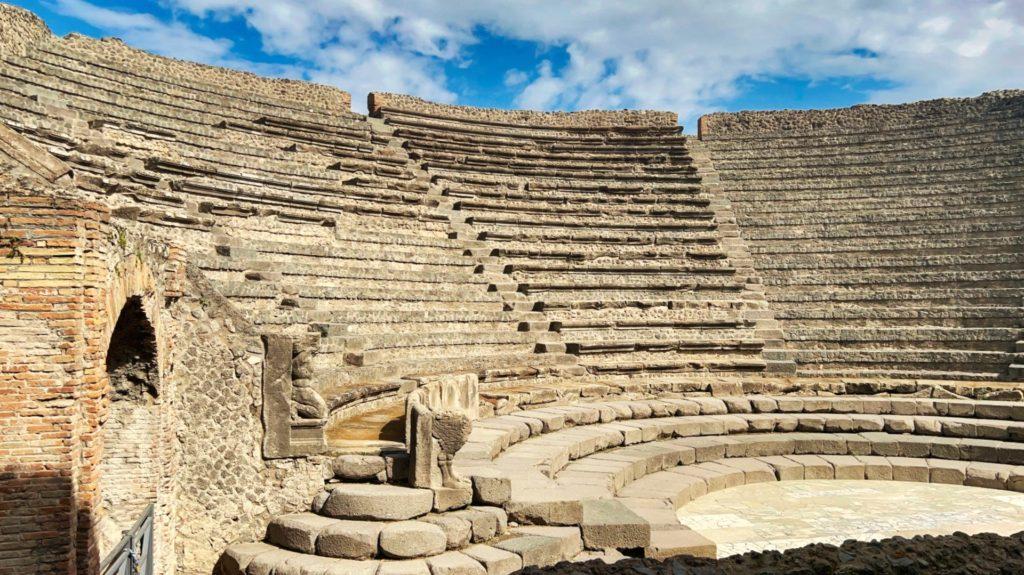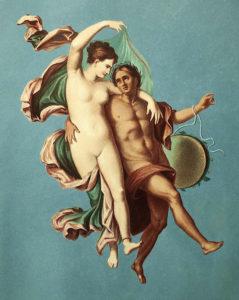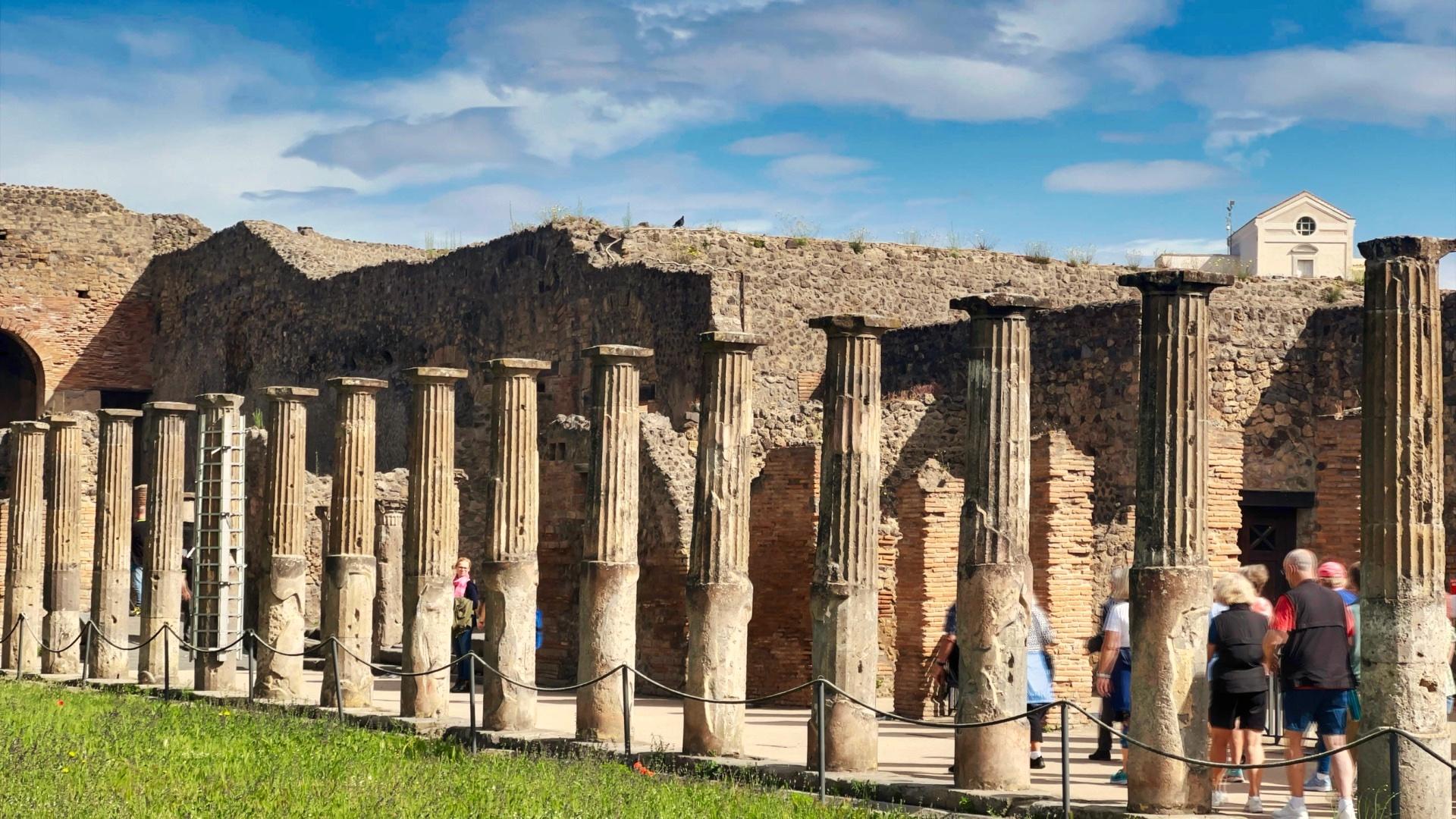Pompeii was the sexual predecessor to the sin-friendly settlements of Nevada and the Netherlands. It's where—almost 80 years after the scapegoat for sexual shame was born—the Ancient Romans and Greeks were still getting busy “getting busy.” But in 79CE, everyone who was getting laid in the city's many brothels, suddenly and tragically, got fuuuuuucked.

How Pompeii was nearly erased from ancient history.
On August 24th of that year, mainland Europe's only active volcano, Mount Vesuvius, erupted. Slowly, at first, but then it began spewing 1.5 millions tons of pyroclastic rock, pumice, and ash, per second!
The volcano's hot sputum lofted twenty miles into the sky over the cities of Pompeii and Herculaneum. Unfortunately, all that ash didn't stay up in the clouds.

At the base of the volcano, Herculaneum and its inhabitants got ashed almost immediately. The people of Pompeii, who lived six miles away, had a bit more time—but not much more time.
Mount Vesuvius' massive ashfall soon fell back to earth. It suffocated, scorched, and/or snuffed out the inhabitants of Pompeii in about seventeen minutes. Here, you can watch it happen in this cheery video:
In less than 48 hours, Pompeii became a huge ash-hole.

The first phase rained ash and pumice down for about 18 hours. During that time, the smart people grabbed their shit and ran. Most of Pompeii's 11,000 inhabitants escaped, but an estimated 2,000 citizens remained.
These morons insisted that the impending volcano eruption was “fake news.” They ranted that the falling ash was merely dandruff from the moon goddess, Luna. And they were wrong.
By the time they wised up, there wasn't enough time to avoid the torrent of terroir raining back down to Earth. Especially not for this unfortunate bastard (see photo). Ouch.
The eruption was memorable, the city, not so much.

Nearly 250 acres of downtown Pompeii were rapidly filled in with ash to a depth of 23-feet, or about two stories. The eradication of Pompeii was so utterly complete that, within a few short years, no one living in the area could even remember where the city, river, or port used to be (see also, Lost City of Machu Picchu).

Erasing an entire city from the populace's memory would require an ashload of volcanic dust to bury all trace of it. (Of course, if that ash had a lot of lead in it, the resulting blood poisoning and IQ-drop would do the job, too.) Luckily, one man was close enough to witness the devastation, but far enough away to survive it and tell the tale.
“Now, let's cut to our man on the scene. Take it away, Pliny.”
Though following generations forgot about Pompeii, most scholars were aware of the city's existence. Specifically, thanks to ancient written sources such as an eyewitness account by Pliny the Younger. Like all pre-Internet writers, Pliny had plenty of free time to record every detail of the disaster. He even included a short story of his supposedly “intelligent” uncle, Pliny the Elder.

“As the eruption raged, Pliny the Elder sailed towards his hometown of Herculaneum at the base of the volcano to rescue people. When burning cinders fell on the ship, Pliny was advised to turn back. But Pliny—a cocky and corpulent fat-ass with a chronic respiratory condition—pressed ahead, infamously proclaiming ‘Fortune favors the bold!' before promptly dying from smoke asphyxiation.”
—Pliny the Younger and Smarter (paraphrased)
For 1700+ years, Pompeii remained little more than a legend.

Despite the fact that Pliny's account went viral—garnering huge traffic, engagement, and shares among scholars—it wasn't until 1738 CE that there were any large-scale excavations of the region. These first efforts to remove ash were motivated by scientific curiosity, a boom in the skincare market, and the desire to make bank selling ancient works of art on eBay.

Over the following 250 years, Italian archeologists painstakingly excavated Pompeii, unearthing pumice from about 163 acres of the ancient city. More impressively, they removed these mountains of ash using nothing more than espresso spoons and pasta colanders.
Today, only 54 acres still remain buried in Vesuvius' ejaculate. Yet, what's already been removed has given us a rare glimpse into human civilization before Christianity ruined the fun for everyone.

Unlike boring Christians, the Romans were totally DTF.

The people of Ancient Rome were not prudes. Unencumbered by the burdensome yoke of Christian “values” and mores, Romans instead considered sex a normal and healthy part of their otherwise joyless 30-year life expectancies. Regular sex was seen as a good thing, whether inside a marriage, outside of marriage, or even with the same sex (the Romans were extremely slutty back then).
Heteronormative unions between the Roman elites were arranged solely to produce male heirs, not happy husbands. So married men were expected to pay prostitutes for the really hot, nasty stuff. Respectable wives weren't expected to do anything more than missionary—though it was called “pontif-style” back then—and maybe some light dusting.
Not surprisingly, prostitution was super-popular and legal in the old Roman Empire, both the female and male variety. Ladies with voracious sexual appetites were considered “sex-wolves,” whereas guys exhibiting the same inclinations were considered “customers.”
The word Lupanar is latin for “brothel.”

The Lupanare Grande was, and still is, Pompeii's most famous brothel. Located in the town center (and close to the Stabian Baths for easy, post-coital clean up), Lupanare Grande was a one-stop, doodle-bop emporium. Even today, it's a popular tourist attraction for the world's deviants and perverts.

Yet, the brothel's popularity didn't mean that patrons had a good experience. People who used this brothel had sex on stained stone “beds” with stained mattresses, up against stained walls, on stained floors, or on stained wooden palettes. And nothing takes the bone out of boning like doing the nasty, where it's really nasty.

Privacy wasn't optimal, either. Sure, you got your own “room,” but there wasn't any door, just a curtain. So, everyone could hear you—and you could hear everyone else—crying out “Oh, Jupiter!” as they climaxed. I don't know about you, but I prefer the locked doors and soundproofed walls of today's modern brothels, thank you very much.

Sex was everywhere, not just in the brothels.

Penises are very “in your face” around Pompeii. The plethora of penis carvings and erotic frescoes found in Pompeii suggests that the city was the carnal-capital of Ancient Rome. Racy scenes were present in homes across all sections of society and public spaces. Yet the images weren't viewed as scandalous or embarrassing, not even the freaky homoerotic ones. That's because Ancient Romans were evidently all about The Dick.

The lack of stigma about male nudity made phalli a popular design motif in Pompeii. There were penis-shaped rock carvings, mosaics, statues, necklaces, and air-fryers, all featuring the male member. Heck, if you needed directions to the brothel, there were even phallic signs carved on the road to point the way. Get some, Citizen!
Pompeii continues to rise from the volcanic ashes.

Though the residents of Pompeii at the time likely wouldn't agree, there was a bright spot to this horrific disaster. Since the excavations first started, we've learned a lot about the customs and habits of perhaps the greatest human civilization of all time.

Like the fact that the Romans used public, communal bathrooms. That's right, they shat together in a big room with the seats facing each other. What?!? Then, after stinking up the joint, they'd wipe their disgusting asses with a “tersorium,” literally, a sea sponge on a wooden stick. So gross.

To make matters worse, the Romans never cleaned their toilet brush. Instead, they left the fecal-infested implement for the next person to use on their ass. How the Roman Empire survived cholera, dysentery, norovirus, and hepatitis is beyond me.
But most crucially, the Ancient Romans of Pompeii taught us perhaps life's most important lesson. “Don't build a city near an active volcano, you f#$%&ing idiots.”
It's a Pro Life-Tip somebody should've told the folks in Quito, Ecuador.
Advice, if you're going to Pompeii.
We took a half-day tour of Pompeii, which was great. Though, in retrospect, I would've taken a VR tour of Pompeii. That way, you get to see what the buildings looked like before all those volcano chunks fell on them.



